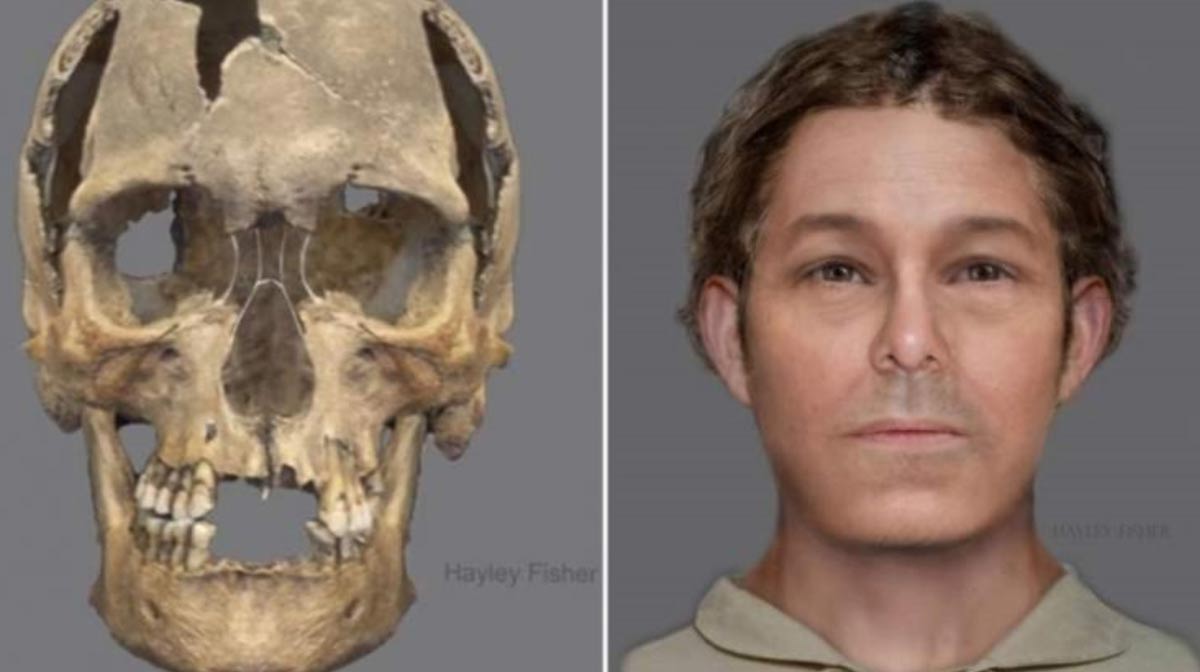600-Year-Old Skeleton found beneath Edinburgh School Playground thought to be Executed Pirate
Archaeologists have completed analyses on a 600-year-old skeleton found last year beneath a primary school playground in Edinburgh, Scotland, and believe it is the remains of a pirate or other criminal who was hanged and gibbeted in nearby Newhaven docklands.
International Business Times reported that the skeleton was discovered by City of Edinburgh Council developers at Victoria Primary School in January last year during survey work to build an extension. It was initially thought that the remains were from the Bronze Age because they were found alongside 4,000-year-old pottery shards. However, recent carbon dating on the bones, carried out by AOC Archaeology, revealed that they belonged to a man in his fifties who lived in 16 th - 17 th century. Forensic artist Hayley Fisher worked with archaeologists to create a facial reconstruction of the man, as shown in the featured image.

The skeleton was discovered under the city's oldest primary school. Credit: City of Edinburgh Council
The school is the city’s oldest primary school and is located close to the old Newhaven docklands, where there once stood a gibbet for hanging pirates, convicted witches, and other criminals, leading historians to believe that the man had been executed for piracy or other criminal behavior, before being dumped in a shallow pit.
“We know that Victoria Primary was built in 1845 on the site of what would have been the shore in Newhaven in the 16th and 17th century,” John Lawson, archaeologist at Edinburgh City Council told Edinburgh Evening News.
“Thanks to carbon-dating techniques, archaeologists now know that the skeleton was likely to have been a murder victim - and quite possibly a pirate," said Councillor Richard Lewis, Culture Convener for the City of Edinburgh Council [via Edinburgh Evening News].
The construction of Newhaven harbor was commissioned in 1504 by King James IV as a royal dockyard to allow for the building of Europe’s largest warship at the time, The Great Michael, a carrack of the Royal Scottish Navy which was too large to be built at any existing Scottish dockyard.

Granton dockyards, Edinburgh, 1860s, close to Newhaven (public domain)
Historic records reveal that a gibbet once stood on the edge of the harbor, looking out to the Firth of Forth, where it was in plain sight of other ships. It was a common practice at the time to place the bodies of executed pirates on display in a gibbet, a gallows-type structure, to deter sailors from succumbing to the temptations of piracy. Live gibbeting also took place in which the condemned was placed alive in a metal cage and left to die of thirst.
The gibbet at Newhaven was built in the mid-16 th century and remained in use until 1822.
“That form of public execution, on a shoreline, just outside a port, was very common, almost as a lesson to the local population of what could happen to them if they are caught,” Mr Lawson told Edinburgh Evening News. “There are accounts of some bodies being left hanging up in gibbets for as long as 20 years.”
- Port Royal and the Real Pirates of the Caribbean
- Vatican releases extraordinary tale of a pope, a pirate, and a dead bishop’s treasure

William Hogarth engraving, 1747 depicting sailors pointing at a man hanging from the gallows at the waterline (public domain).
Piracy plagued the Scottish isles, particularly the smaller islands of the Western Hebrides, which became havens for sixteenth-century pirates. They preyed on Dutch, Lowland Scottish, Flemish, and English merchant ships and fishermen.
Captain Kidd was the most infamous Scottish pirate. He initially won favour with the British establishment when he began targeting French ships, but later expanded his operations and targets. He was captured and tried at London's Old Bailey and hanged and displayed in a gibbet at Execution Dock in 1701.
- 50kg Silver Bar Found in Madagascar may be Treasure of Notorious Pirate Captain Kidd
- The Ultimate Pirate Branding Symbol - the Origin of the Jolly Roger

Scottish pirate, Captain Kidd, hanging in a gibbet at the water's edge to deter other pirates (public domain)
Laura Thomson, the Headteacher at Victoria Primary School said of the discovery: “We are the oldest still-working primary school in Edinburgh and the children are all very proud of the history and heritage in Newhaven. They have a sense of the history all around them. This is another chapter in that.”
Featured image: The skeleton of a man believed to have been in his fifties was discovered near a gibbet used to execute criminals. Credit: City of Edinburgh Council.
By: April Holloway

















